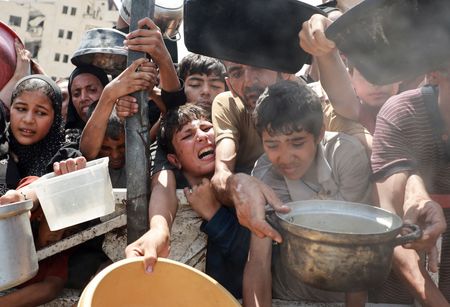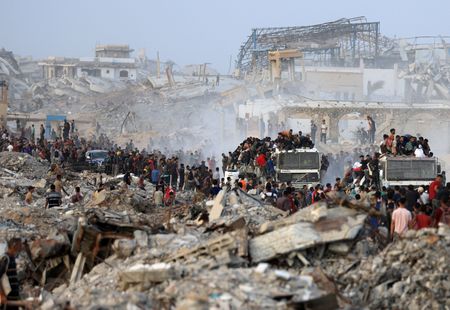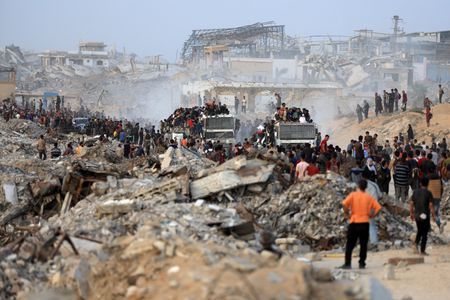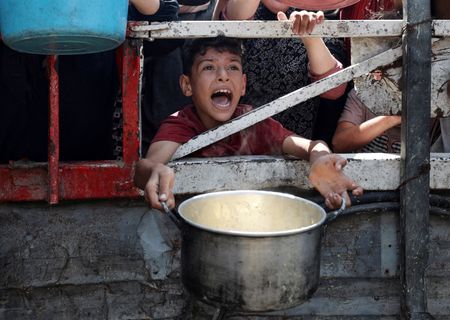By Michelle Nichols, Olivia Le Poidevin and Nidal al-Mughrabi
UNITED NATIONS/GENEVA/CAIRO (Reuters) -A worst-case scenario of famine is unfolding in Gaza and immediate action is needed to avoid widespread death, a hunger monitor warned on Tuesday, as the number of Palestinians reported killed in the conflict with Israel crossed the 60,000 threshold.
The hunger alert and the new death toll are grim milestones in a conflict that began almost two years ago when Hamas attacked Israel, sparking an offensive that has laid waste to much of the enclave and ignited hostilities across the region.
The alert by the Integrated Food Security Phase Classification (IPC) raised the prospect that the man-made starvation crisis in Gaza could be formally classified as a famine, in the hope that this might raise the pressure on Israel to let in far more food.
EVIDENCE OF STARVATION, MALNUTRITION, DISEASE
With international criticism growing, Israel announced steps over the weekend to ease aid access. But the World Food Programme (WFP) said on Tuesday it was not getting the permissions it needed to deliver enough aid since Israel began humanitarian pauses on Sunday.
“Mounting evidence shows that widespread starvation, malnutrition, and disease are driving a rise in hunger-related deaths,” the IPC said, adding that “famine thresholds” have been reached for food consumption in most of the Gaza Strip.
It said it would quickly carry out the formal analysis that could allow it to classify Gaza as “in famine”.
For famine to be declared, at least 20% of the population must be suffering extreme food shortages, with one in three children acutely malnourished and two people out of every 10,000 dying daily from starvation or from malnutrition and disease.
Gaza health authorities have been reporting more and more people dying from hunger-related causes. The total stands at 147, among them 88 children, most of whom died in the last few weeks.
Images of emaciated Palestinian children have shocked the world, with Israel’s strongest ally U.S. President Donald Trump declaring that many people were starving. He promised to set up new “food centres”.
Israel has denied pursuing a policy of starvation. Foreign Minister Gideon Saar said on Tuesday that the situation in Gaza was “tough” but there were lies about starvation there.
DEADLIEST CONFLICT
The death toll of 60,000 announced by Gaza health authorities, whose figures are often cited by the U.N. and have previously described as reliable by the World Health Organisation, underlines this as the deadliest war in the decades-long Israeli-Palestinian conflict.
The previous deadliest conflict between Israel and the Hamas Islamist group – which seized control of Gaza in 2007 – was in 2014, when 2,100 Palestinians were killed in Gaza, mostly civilians, while Israel lost 67 soldiers and six civilians.
Israel launched its latest offensive in response to Hamas’ attacks on October 7, 2023, when militants killed some 1,200 people and took another 251 hostage – Israel’s deadliest ever day.
The new Palestinian toll does not distinguish between fighters and civilians. Thousands more bodies are believed to be buried under rubble, meaning the true toll is likely to be significantly higher, Palestinian officials and rescue workers say.
Israeli airstrikes overnight killed at least 30 Palestinians in Nuseirat camp in central Gaza, Gaza health authorities said. Doctors at Al-Awda Hospital said at least 14 women and 12 children were among the dead.
The hospital also said that 13 people had been killed and dozens wounded by Israeli fire along the Salahudeen Road as they waited for aid trucks to roll into Gaza.
A total of 55 Palestinians were killed in attacks overnight, Gaza health authorities said. The Israeli military did not immediately respond to a request for comment.
Fifty of the hostages seized on October 7 remain in Gaza, of whom 20 are believed to be alive.
The latest talks aimed at securing a ceasefire and freeing the hostages collapsed last week. Netanyahu said on Sunday that Israel would keep fighting until the hostages were freed and Hamas’ military and governing capabilities destroyed.
ONLY HALF OF REQUESTS APPROVED
Saar said 5,000 aid trucks had entered Gaza in the last two months, and that Israel would assist those wanting to conduct airdrops – a delivery method that aid groups say is ineffective and tokenistic.
Ross Smith, a senior regional programme adviser at the World Food Programme, told reporters in Geneva by video: “We’re getting approximately 50% of what we’re requesting into Gaza since these humanitarian pauses started on Sunday.
“We are not going to be able to address the needs of the population unless we can move in the volume that we need.”
After an 11-week Israeli blockade, limited U.N.-led aid operations resumed on May 19 and a week later the obscure new U.S.-based Gaza Humanitarian Foundation – backed by Israel and the United States – began distributing food aid.
The rival efforts have sparked a war of words – pitting Israel, the U.S. and the GHF against the U.N., international aid groups and dozens of governments from around the world.
Israel and the U.S. accuse Hamas of stealing aid – which the militants deny – and the U.N. of failing to prevent it. The U.N. says it has not seen evidence of Hamas diverting much aid. Hamas accuses Israel of causing starvation and using aid as a weapon.
The IPC said 88% of Gaza was now under evacuation orders or within militarised areas, and was critical of GHF efforts.
It said most of the GHF food items “require water and fuel to cook, which are largely unavailable”.
The IPC’s Famine Review Committee said: “Our analysis of the food packages supplied by the GHF shows that their distribution plan would lead to mass starvation.”
GHF said its aid boxes are based on the same ingredient lists used by other aid groups and meet standards for total calories and nutritional value.
(Reporting by Michelle Nichols and Olivia Le Poidevin; additional reporting by Lena Masri in London; Steven Scheer in Jerusalem; Writing by Michelle Nichols and Tom Perry; Editing by Don Durfee and Kevin Liffey)













